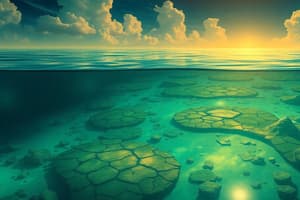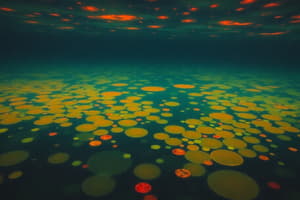Podcast
Questions and Answers
Which of the following best describes a dead zone?
Which of the following best describes a dead zone?
- An area in the ocean characterized by extreme temperatures and unique geological formations.
- An area in the ocean with very low oxygen concentration and limited marine life. (correct)
- An area in the ocean with a high concentration of oxygen and abundant marine life.
- An area in the ocean with a balanced ecosystem and diverse species.
What is the primary cause of algal blooms that lead to the formation of dead zones?
What is the primary cause of algal blooms that lead to the formation of dead zones?
- The overpopulation of fish species.
- The introduction of excessive chemical nutrients into the water. (correct)
- Increased levels of carbon dioxide in the atmosphere.
- A sudden decrease in water temperature.
Which human activity can enhance the formation of dead zones?
Which human activity can enhance the formation of dead zones?
- The use of microorganisms to degrade pollutants.
- Sustainable fishing practices.
- Reforestation projects in coastal areas.
- Agricultural runoff containing fertilizers. (correct)
What is the main purpose of bioremediation?
What is the main purpose of bioremediation?
What is the key difference between in-situ and ex-situ bioremediation?
What is the key difference between in-situ and ex-situ bioremediation?
What does bioventing involve in the context of bioremediation?
What does bioventing involve in the context of bioremediation?
In the context of bioremediation, what is bioaugmentation?
In the context of bioremediation, what is bioaugmentation?
What is the purpose of 'land forming' in ex-situ bioremediation?
What is the purpose of 'land forming' in ex-situ bioremediation?
What is the role of indigenous biodegradative microorganisms in land forming?
What is the role of indigenous biodegradative microorganisms in land forming?
Which of the following best describes the function of bioreactors in bioremediation?
Which of the following best describes the function of bioreactors in bioremediation?
What is composting, in the context of bioremediation?
What is composting, in the context of bioremediation?
What is a primary air pollutant?
What is a primary air pollutant?
How are secondary air pollutants formed?
How are secondary air pollutants formed?
Which of the following is an example of a secondary air pollutant?
Which of the following is an example of a secondary air pollutant?
What distinguishes quantitative pollutants from qualitative pollutants?
What distinguishes quantitative pollutants from qualitative pollutants?
What is the key characteristic of biodegradable pollutants?
What is the key characteristic of biodegradable pollutants?
Which of the following is an example of a non-biodegradable pollutant?
Which of the following is an example of a non-biodegradable pollutant?
What are anthropogenic sources of air pollution?
What are anthropogenic sources of air pollution?
Which of the following is a natural source of air pollution?
Which of the following is a natural source of air pollution?
What are the major sources of suspended particulate matter (SPM)?
What are the major sources of suspended particulate matter (SPM)?
What distinguishes PM2.5 from PM10?
What distinguishes PM2.5 from PM10?
What is fly ash primarily composed of?
What is fly ash primarily composed of?
What is the primary impact of fluoride particles on vegetation and cattle?
What is the primary impact of fluoride particles on vegetation and cattle?
What is a major effect of pathogens as water pollutants?
What is a major effect of pathogens as water pollutants?
What effect do inorganic pollutants, such as nitrates, have on water bodies?
What effect do inorganic pollutants, such as nitrates, have on water bodies?
Why is heat considered a water pollutant?
Why is heat considered a water pollutant?
What is the purpose of sedimentation in water treatment?
What is the purpose of sedimentation in water treatment?
What is the function of coagulants in water treatment?
What is the function of coagulants in water treatment?
During water softening, what substances are removed from the water?
During water softening, what substances are removed from the water?
Flashcards
Dead Zones
Dead Zones
Areas in the ocean with very low oxygen concentration (hypoxic conditions).
Bioremediation
Bioremediation
Uses microorganisms (bacteria and fungi) to degrade environmental contaminants into less toxic forms.
Bioventing
Bioventing
Involves supplying nutrients through wells to contaminated soil to stimulate the growth of bacteria.
Biosparging
Biosparging
Signup and view all the flashcards
Bioaugmentation
Bioaugmentation
Signup and view all the flashcards
Ex-situ Bioremediation
Ex-situ Bioremediation
Signup and view all the flashcards
Land Forming
Land Forming
Signup and view all the flashcards
Air Pollution
Air Pollution
Signup and view all the flashcards
Primary Pollutants
Primary Pollutants
Signup and view all the flashcards
Secondary Pollutants
Secondary Pollutants
Signup and view all the flashcards
Quantitative Pollutants
Quantitative Pollutants
Signup and view all the flashcards
Qualitative Pollutants
Qualitative Pollutants
Signup and view all the flashcards
Biodegradable Pollutants
Biodegradable Pollutants
Signup and view all the flashcards
Non-Biodegradable Pollutants
Non-Biodegradable Pollutants
Signup and view all the flashcards
Natural pollutant origin
Natural pollutant origin
Signup and view all the flashcards
Anthropogenic pollutant origin
Anthropogenic pollutant origin
Signup and view all the flashcards
Particulate Pollutants
Particulate Pollutants
Signup and view all the flashcards
Fly Ash
Fly Ash
Signup and view all the flashcards
Water Pollution: Primary Treatment
Water Pollution: Primary Treatment
Signup and view all the flashcards
Sedimentation
Sedimentation
Signup and view all the flashcards
Coagulation
Coagulation
Signup and view all the flashcards
Filtration
Filtration
Signup and view all the flashcards
Water Pollution: Secondary Treatment
Water Pollution: Secondary Treatment
Signup and view all the flashcards
Aeration
Aeration
Signup and view all the flashcards
Water Pollution: Tertiary Treatment
Water Pollution: Tertiary Treatment
Signup and view all the flashcards
Skimmers for Oil Spills
Skimmers for Oil Spills
Signup and view all the flashcards
Sorbents for Oil Spills
Sorbents for Oil Spills
Signup and view all the flashcards
Bioremediation for Oil Spills
Bioremediation for Oil Spills
Signup and view all the flashcards
Fertilisers in Water Pollution
Fertilisers in Water Pollution
Signup and view all the flashcards
Oil Spills
Oil Spills
Signup and view all the flashcards
Study Notes
- Dead zones are biological deserts or hypoxic zones in the ocean with very low oxygen concentration (hypoxic conditions).
- Dead zones emerge when the influx of excess chemical nutrients spurs algae growth or algal blooms.
- Dead zones usually occur 200-800 meters below the surface, in the saltwater layer.
- Hypoxic zones can occur naturally due to the upwelling of excess nutrients.
- Human activity can quicken the formation of dead zones.
- Dead zones are detrimental to animal life.
- Most of the animal life either dies or migrates from the zone.
Bioremediation
- Bioremediation uses microorganisms (bacteria and fungi) to degrade environmental contaminants into less toxic forms.
- Microorganisms can be specifically designed for bioremediation using genetic engineering techniques.
In situ bioremediation
- In situ bioremediation occurs at the site of contamination.
- Bioventing supplies nutrients through wells to contaminated soil, stimulating bacteria growth.
- Biosparging involves injecting air under pressure below the water table to increase groundwater oxygen concentrations, enhancing biological degradation of contaminants by bacteria.
- Bioaugmentation introduces microorganisms to a contaminated site, enhancing the degradation process.
Ex-situ bioremediation
- Ex-situ bioremediation involves removing the contaminated material for treatment elsewhere.
- Land farming entails excavating contaminated soil and spreading it over a prepared bed, periodically tilling it until pollutants are degraded.
- The goal of land farming is to stimulate indigenous biodegradative microorganisms and facilitate their aerobic degradation of contaminants.
- Bioreactors process contaminated solid material (soil, sediment, sludge) or water through an engineered containment system.
- Composting is nature's recycling of decomposed organic materials into a rich soil known as compost.
Air Pollutants
- Air pollution refers to undesirable changes in the physical and chemical constituents of air due to human activities.
Sources
- Primary pollutants are directly released into the atmosphere.
- Secondary pollutants result from reactions with atmospheric pollutants.
Mode of Release
- Indoor pollutants come from cooking, smoking, air conditioning, etc.
- Outdoor pollutants come from industrial processes and transportation.
Chemical Composition
- Particulate matter can be solid or liquid aerosols.
- Gaseous pollutants mix with air in vapor form.
Basis of Persistence
- Primary pollutants persist in their original form when added to the environment.
- Secondary pollutants are formed by interactions among primary pollutants.
Basis of Existence in Nature
- Quantitative pollutants occur naturally but become pollutants when concentrations exceed a threshold level.
- Qualitative pollutants are man-made and don't occur in nature.
Basis of Biodegradability
- Biodegradable pollutants are waste products degraded by natural microbial action.
- Non-biodegradable pollutants don't decompose naturally or decompose slowly.
Basis of Origin
- Natural pollutants are released during natural processes.
- Anthropogenic pollutants are released during human activities.
Natural Sources of Air Pollution
- Includes ash from erupting volcanoes, dust from storms, forest fires, and pollen grains from flowers.
Human Sources of Air Pollution
- Power stations using coal/crude oil, furnaces, steam engines, internal combustion engines, household fuels, sewers, pesticide residues, agriculture, waste treatment, biomass burning.
Particulate Pollutants
- Particulate pollutants involve matter suspended in the air like dust and soot.
- Major sources of suspended particulate matter (SPM) include industries, vehicles, power plants, construction activities, oil refineries, railway yards, and marketplaces.
- PM10 are inhalable particles, generally 10 micrometers or smaller, from sources like construction, pollen, and emissions.
- PM2.5 are fine inhalable particles, generally 2.5 micrometers or smaller, often from combustion processes.
- Fly ash is an end product of coal combustion during power generation.
- Fly ash consists of silica, alumina, oxides of iron, calcium, magnesium, and toxic heavy metals.
- Fly ash is used in manufacturing cement, bricks, tiles, road embankment construction, etc.
- ASH TRACK Mobile App was launched by the Ministry of Power for better management of fly ash.
- ASH TRACK Mobile App provides an interface between fly ash producers and potential users.
Fluorides
- Fluorides come from aluminum, steel, electrochemical plants, blast furnaces, brick kilns, coal combustion, and glass etching factories.
- Volcanoes also release fluorides as gas or particulate pollutants.
- Fluoride particles settle on vegetation, burning leaf tips, leading to fluorosis in cattle, causing tooth loss, weight loss, and lameness.
Water Pollutants
- Pathogens in sewage, human/animal wastes, and runoff deplete dissolved oxygen and cause waterborne diseases.
- Organic pollutants like oil, grease, pesticides, plastics, and detergents disrupt marine life and can have toxic effects.
- Inorganic pollutants like fertilizers cause algal blooms, eutrophication, and can cause methemoglobinemia from nitrates.
- Acids and alkalies from mine drainage and industrial wastes kill freshwater organisms.
- Radioactive materials cause cancer and genetic defects.
- Heat decreases oxygen solubility.
- Sediments affect water quality and fish populations.
Water Pollution: Control Measures
- Treatment of wastewater before discharge involves sedimentation, coagulation, and filtration as primary treatment.
Primary Treatment
- Sedimentation allows silt, clay, and other matter to settle.
- Coagulation combines fine particles and colloidal suspensions into larger particles using chemicals like potash alum.
- Filtration removes suspended particles, flocculants, bacteria, and organisms through sand or fibrous materials.
- Sludge collected is used as fertilizer.
Secondary Treatment
- Softening removes undesirable calcium and magnesium cations from hard waters.
- Aeration exposes soft water to air, adding oxygen and encouraging bacterial decomposition of organic matter.
Tertiary Treatment
- Chlorine is a commonly used disinfectant.
- Other disinfection methods include ultraviolet radiation, ozone gas treatment, or reverse osmosis.
Oil Spills
- Skimmers physically retrieve oil, separating it from water.
- Sorbents absorb oil from the surface.
- Chemical surfactants can associate oil into smaller particles and accelerate dispersion.
- Bioremediation uses microorganisms to speed up natural biodegradation.
Heavy Metals
- Heavy metals ions found in water include Copper, Zinc, Silver, Chromium, Arsenic, Mercury, Cadmium, and Lead.
Agricultural Sources of Water Pollution
- Fertilizers containing nitrogen, phosphorus, and potassium.
- Pesticides containing chlorinated hydrocarbons organophosphates, metallic salts, carbonates, thiocarbonates, derivatives of acetic acid.
- Animal excreta.
- Excess nitrate in drinking water reacts with hemoglobin to form non-functional methaemoglobin, impairing oxygen transport.
- High nitrate levels may form carcinogens and accelerate eutrophication.
Thermal Pollution
- Thermal pollution occurs from thermal power plants and nuclear plants releasing hot water, decreasing dissolved oxygen.
Marine Pollution
- Marine pollution includes coastal city sewage, garbage disposal, navigational discharge of oil, detergents, and radioactive waste.
- Oil spills are uncontrolled releases of crude oil, gasoline, or other oil products into the atmosphere.
- Oil spills can contaminate land, air, or water.
- Oil spills are a major environmental problem, due to petroleum exploration, production on continental shelves, and transport of large amounts of oils in vessels.
- Oil spills are harmful to aquatic life, preventing sunlight penetration and reducing dissolved oxygen.
- Oil contains many toxic compounds that can cause health problems and death.
Methods to Clear Oil Spills
- Oil booms use floating barriers to stop spreading oil, which could be retrieved.
Community Waste Water
- Community wastewater includes discharges from houses, commercial and industrial establishments connected to a sewerage system.
- Community wastewater consists of human and animal excreta, food residues, cleaning agents, detergents, and other wastes.
Industrial Waste
- Industrial waste discharges several inorganic and organic pollutants.
Studying That Suits You
Use AI to generate personalized quizzes and flashcards to suit your learning preferences.




